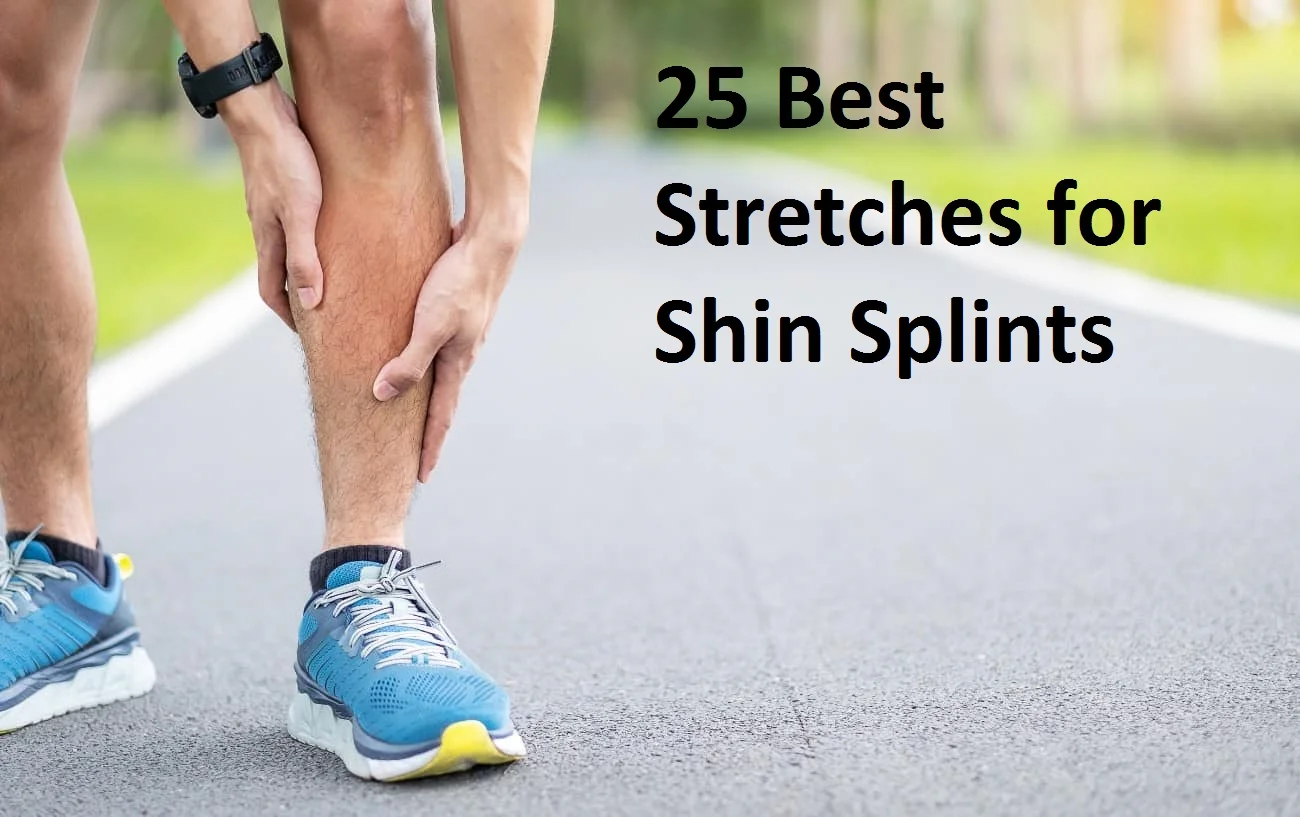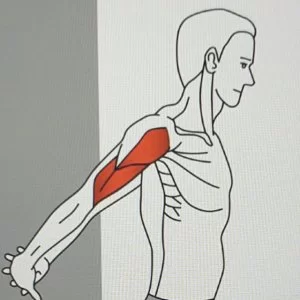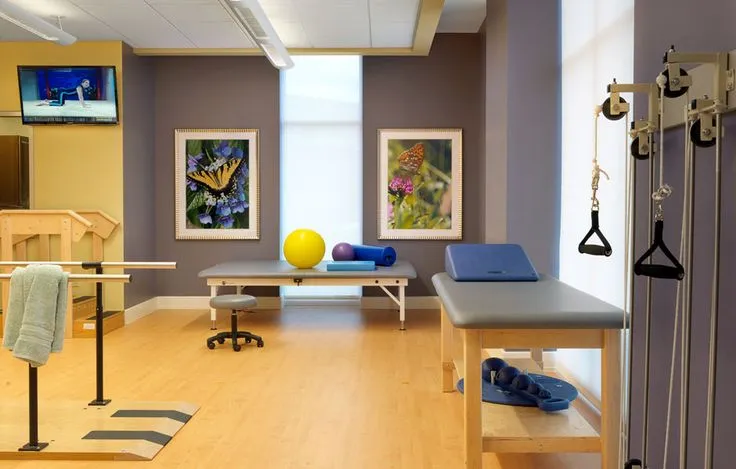25 Best Stretches for Shin Splints
Introduction:
Shin splints, also known as medial tibial stress syndrome, are a common injury that affects the shinbone (tibia) and the surrounding muscles.
Shin splints are a common overuse injury. Shin splints can occur when you overwork the muscle and bone tissue in the leg through repetitive activity. Shin splints are a common injury suffered by sports and dancers. Foot and ankle stretches can help improve movement so that we can prevent shin splints.
One effective approach to managing shin splints is incorporating stretching exercises into your routine. Stretching can help alleviate tightness in the muscles surrounding the shinbone, improve flexibility, and reduce the risk of further injury. While there are various stretches that can be beneficial for shin splints, it’s important to consult with a healthcare professional or a qualified trainer to determine the most appropriate stretches for your specific condition.
Benefits of Stretches for shin splints:
If you are doing regular stretching sessions, then here are the benefits,
- Muscle relaxation
- Reduce pain
- Improve flexibility
- Reduce tension or tightness.
- Improves daily activity function
- Improves range of motion
- Reduce inflammation
- Stretches help to improve your balance and coordination.
- Stretches are also great for reducing stress levels, as they help you to balance your mind and body better by relaxing the muscles.
- Stretches reduce pain and stiffness
The Best Stretches for Shin Splints:
In this guide, we will explore some of the best stretches for shin splints that can help alleviate pain, promote healing, and prevent future occurrences. It’s important to note that while stretching can provide relief, it should be combined with other treatment methods, such as rest, ice, proper footwear, and gradual return to activity, for optimal recovery.
The following stretch exercises are effective for shin splints,
Gastrocnemius calf stretch
- Put your hands against a wall or the back of a chair for support as you stand calmly to begin.
- Put a foot behind you now.
- Maintain a flat foot position.
- While maintaining your back heel down and your back leg straight, bend your front knee until you feel a stretch in your back leg’s calf.
- Throughout the stretch, maintain a straight back.
- Hold this position for a short while.
- Then take a position that is neutral.
- Then relax.
- Switch leg and repeat.
- The stretching should be done three to five times daily.
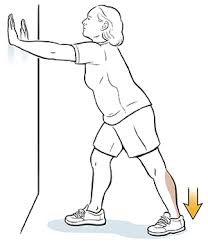
Soleus calf stretch
- In the beginning, take a position facing a closed door or a wall.
- Put your both hands on the wall.
- After then, put one foot slightly in front of the other.
- To feel the stretch, slowly crouch down so that both of your knees are bent.
- Keep your heels planted on the floor.
- Hold this position for a short while.
- Then take a position that is neutral.
- Then relax.
- The stretching should be done three to five times daily.
- Switch leg and repeat.
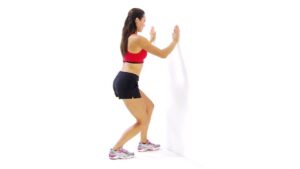
Achilles tendon seated stretch
- Sit on the ground to begin.
- With your heel on the ground, extend the opposite leg in front of you while bending one knee.
- Pull your toe towards you by wrapping an exercise band, towel, or belt around the ball of your foot.
- Hold this position for a short while.
- Then take a position that is neutral.
- Then relax.
- The stretching should be done three to five times daily.
- Switch leg and repeat.

Tibialis anterior muscle stretch
- Begin by kneeling down on a step or on the floor.
- Slowly stand up on your toes, then slowly come down.
- As your heels come down, flex your calf and foot muscles.
- Hold this position for a few seconds.
- Then return to your neutral position.
- Then relax.
- The stretching should be done three to five times daily.

Calf raises
- Start by standing with your feet up on a step or step stool.
- Slowly stand up on your toes, then slowly come down.
- As the heels of your feet come down, flex your calf and foot muscles.
- Hold this position for a few seconds.
- Then return to your neutral position.
- Then relax.
- The stretching should be done three to five times daily.
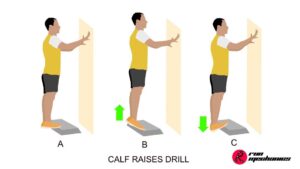
Kneeling shin stretch
- Beginning on all fours, softly squat down with your heels under your glutes.
- Lean back and put your hands on the ground in the back.
- Increase pressure while gently pressing the heels down.
- Hold this position for a short while.
- Then return to your neutral position.
- Then relax.
- Repeat 3-5 times.
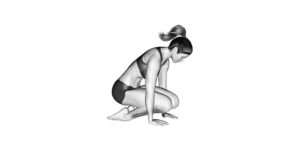
Seated shin stretch
- Start with sitting in a chair.
- Bend one knee till the toe touches the ground and the knee stretches in front of the other.
- With the toe firmly placed on the ground, slowly shift your body weight forward until you feel a stretch in your shin.
- Hold this position for a few seconds.
- Then return to your neutral position.
- Then relax.
- If desired, switch legs and carry out the stretch on the opposite side.
- Repeat 3-5 times each day.
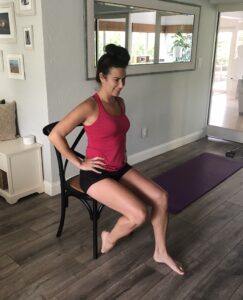
Achilles tendon standing stretch
- Start with relaxed standing and Putting the balls of your feet on the edge of the surface by using a step.
- Hold onto something substantial for support, like a piece of furniture, exercise equipment, or a railing.
- Allow one foot to dangle until the back of the leg starts to ache.
- Hold this position for a few seconds.
- Then return to your neutral position.
- Then relax.
- Switch leg and repeat.
- The stretching should be done up to 3-5 times daily.

Seated Calf Stretch
- Straighten your knees when you sit on the ground.
- To lift your foot to a fully extended position, wrap a rope or towel around the front of your foot.
- Keep your legs parallel to the ground.
- Your ankle joints should be the only points of motion.
- Hold this position for a few seconds.
- Then return to your neutral position.
- Then relax.
- Switch leg and repeat.
- The stretching should be done up to 3-5 times daily.
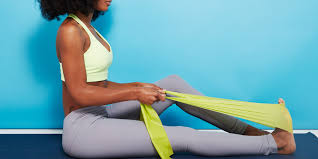
Hamstring wall stretch
- Starting at a doorway, lie on your back with your left leg through the aperture and your right leg straight up the wall. Your legs should be in the shape of an L.
- When you feel a stretch in your right hamstring, make sure your butt is pushed up against the door so your legs are parallel.
- Hold this position for a few seconds.
- Then return to your neutral position.
- Then relax.
- Switch leg and repeat.
- The stretching should be done up to 3-5 times daily.

Low Runner’s Lunge
- Starting from a standing position, advance quickly with your right foot until you are in a low lunge.
- Lowering the chest onto the top of the right thigh while deepening the stretch.
- A stretch will be felt in the right leg’s calf and ankle.
- Hold this position for a few seconds.
- Then return to your neutral position.
- Then relax.
- Switch leg and repeat.
- The stretching should be done up to 3-5 times daily.
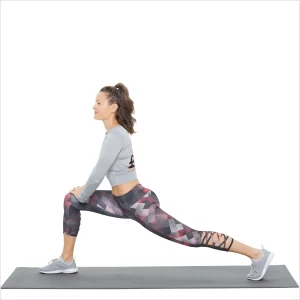
Toe rise
- Start with a relaxed stand on the floor.
- Lifting your heels off the ground, stand up straight on your toes.
- Hold this position for a few seconds.
- Return your heels to the ground gradually.
- Then relax.
- Switch leg and repeat.
- The stretching should be done up to 3-5 times daily.
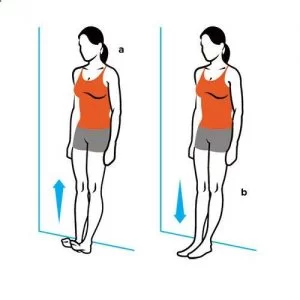
Single Leg Bridge
- Start with lying flat on your back.
- Your straight arms should be by your side.
- Put your feet firmly on the ground while bending your knees.
- Raising your hips to the ceiling while bending your knees to a 90-degree angle.
- Grasp the ground with your heels and the backs of your shoulders.
- Maintaining a high hip position, lift one leg straight into the air.
- Hold this position for a few seconds.
- Then return to your neutral position.
- Then relax.
- Switch leg and repeat.
- The stretching should be done up to 3-5 times daily.
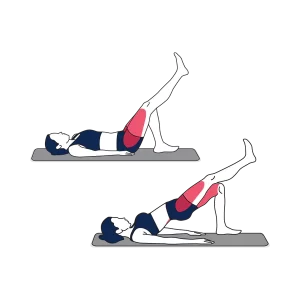
Ankle Dorsiflexion Stretch
- Start with a stand facing a wall.
- Keep your heel on the ground.
- Keep your knee straight.
- Put your front foot’s bottom up against the wall.
- Your calf muscles will feel stretched.
- Hold this position for a few seconds.
- Then return to your neutral position.
- Then relax.
- The stretching should be done up to 3-5 times daily.
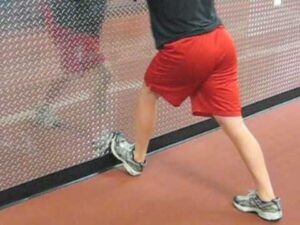
Foot Step Holds
- Stand comfortably with your feet shoulder-width apart.
- With one leg, move normally and allow your heel to touch the ground.
- Avoid letting the front of your foot touch the floor by stopping before it does.
- Avoid letting the front of your foot touch the ground.
- Hold this position for a few seconds.
- Then return to your neutral position.
- Then relax.
- The stretching should be done up to 3-5 times daily.
Standing hamstring stretch
- Begin by standing in a relaxed position on the ground.
- Maintain a straight back and slowly budge forward from your hips until you feel a tiny pull in the back of your leg.
- for support use a small stool or table to put your one leg to feel the stretch.
- Hold this position for a few seconds.
- Then return to your neutral position.
- Then relax.
- Switch leg and repeat.
- Repeat 3-5 times.
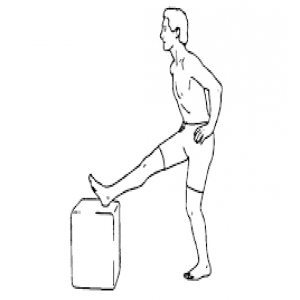
Towel Stretch
- Just put your toes on top of a towel that has been wrapped up and placed behind your foot.
- Pull the cloth with both hands until you feel a slight stretch in your calf.
- Hold this position for a few seconds.
- Then return to your neutral position.
- Then relax.
- Switch leg and repeat.
- Repeat 3-5 times.

Toe Flexor Stretch
- Take a seating position while keeping your feet firmly on the ground.
- Next, grasp the towel (optional) firmly in both hands while curling your toes under.
- Hold this position for a few seconds.
- Then return to your neutral position.
- Then relax.
- Switch leg and repeat.
- Repeat 3-5 times per day.

Foam Roller Stretch
- Set the foam roller down on the ground.
- Your shins should be in a position to rest on top of it.
- Next, rock back and forth for a couple of minutes.
- Then return to your neutral position.
- Then relax.
- Switch leg and repeat.
- Repeat 3-5 times per day.

Shin Stretch
- Start by standing up straight and placing one foot on a bench or chair just above the knee.
- When you feel a slight tug in the front of your leg, carefully bend forward at the hips.
- Hold this position for a few seconds.
- Then return to your neutral position.
- Then relax.
- Switch leg and repeat.
- Repeat 3-5 times per day.

Standing Anterior Tibialis Shin Stretch
- Start by standing up comfortably.
- For balance, you can rest your hand on a wall or another object.
- Both knees are slightly bent.
- Next, place a foot firmly on the ground.
- Place your other foot so that the toe of the stretched foot touches the ground and is immediately behind this stable foot.
- You can feel a stretch from the top of your stretching foot into your shins by pulling the stretching leg forward while maintaining your toe firmly planted on the ground.
- Hold this position for a few seconds.
- Then return to your neutral position.
- Then relax.
- Repeat 3-5 times.
- Switch legs and repeat.

Lying Shin Stretch
- Start with relaxing and lie down on your side.
- Your upper leg should be bent so that your foot is now behind your back.
- You can draw your forefoot to your back by reaching back and grabbing it.
- Hold this position for a few seconds.
- Then return to your neutral position.
- Then relax.
- Repeat 3-5 times.
- Switch legs and repeat.

Soleus step stretch
- Start with relaxing and standing on a step with both feet.
- Your left foot’s heel should be lifted off the step’s edge.
- Allow your left heel to sag and flex your right knee slightly. (Your left calf should feel this stretch.)
- Hold this position for a few seconds.
- Then return to your neutral position.
- Then relax.
- Repeat 3-5 times.
- Switch legs and repeat.

Ankle circles
- Start with relaxing and sit on the floor with one or both legs stretched out in front of you.
- Put a small foam roller or a cloth that has been rolled up under your ankle(s).
- Slowly rotate your ankle(s) both clockwise and anticlockwise.
- Hold this position for a few seconds.
- Then return to your neutral position.
- Then relax.
- Repeat 3-5 times.
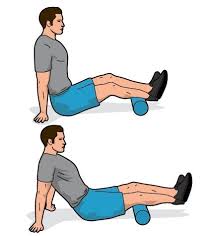
Standing Calf Stretch
- Start with standing upright with facing a wall.
- Place one leg straight behind you and your other leg in front of you.
- Keep the heel of your other foot on the floor.
- Then lean forward against the wall.
- Once you feel a pull on the back of your left calf muscles.
- Stay in this position.
- Hold this position for a few seconds.
- Then return to your neutral position.
- Then relax.
- Repeat 3-5 times.
- Switch legs and repeat.

What precautions are required during stretching?
- Warm-up and gentle stretch.
- Maintain good posture while performing stretching.
- Avoid painful stretches
- Stop stretching if you feel a sudden pain
- Take rest between stretches
- Stay hydrated.
When do you not perform stretching?
- Severe muscle burning
- You’re feeling sick.
- If you feel any pain or numbness.
- Fever
- Headache
What exercise or activity you should avoid with shin splints?
- High jumping
- Running
- Sports activity
- Racing
- Avoid repetitive exercise and stretches
Remember to listen to your body and avoid any movements or stretches that cause excessive pain or discomfort. If you experience persistent or worsening symptoms, it’s essential to seek medical advice for a proper diagnosis and comprehensive treatment plan. With that said, let’s dive into the best stretches for shin splints to aid in your recovery and prevent future occurrences.
Recovery time for Shin Splints
Shin splints Recovery time varies, depending on the age, condition, and health of each person. It also depends upon quality treatment and recommendations.
In general, Mostly younger people, athletes, or more fit older adults who are compliant with recommendations recover in 3 to 4 months. For those with more significant strength and flexibility impairments, or issues that may impact mechanics and healing, my experience is that recovery may take upwards upto six months.
FAQs
How does stretching help shin splints?
Shin stretches can help prevent shin splints. Shin splint stretches aim at the calf muscles which are the soleus muscles. You can do
these stretches before or after exercise in daily routine.
Can stretching prevent shin splints?
Foot and ankle stretches can improve movements and help prevent shin splints. stretching program is helpful to strengthen the leg muscles around your ankle, foot, and upper legs to help prevent shin splints.
What stretches work best for treating shin splints?
Gastrocnemius calf stretch
Soleus calf stretch
Calf raises
Kneeling shin stretch
Seated shin stretch
Toe Drag
Towel stretch
How often should someone with shin splints do stretches?
The stretches for the shin splints can be done daily for a minimum of 15- 30 minutes.
You will get benefit from a gentle daily stretching routine.
What is a simple home stretch for shin splints?
Standing Calf Stretch
Ankle circles
Standing Hamstring Stretch
Ankle Dorsiflexion Stretch
Single leg bridge
Toe raise
Toe drag

